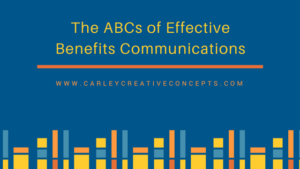After you and your team have done all the research and planning and finalized your benefits for the new year, it’s time to develop a communication plan and communication pieces. Whether you are making major changes to your company’s benefits or just making minor changes such as regulatory adjustments, there are some basics to keep in mind. To make it simple, think of the ABC’s.
A – Accentuate the Positive
Some companies are tasked with adjusting employee contributions greatly. One company I worked with had acquired another company and needed to double the employee contributions and streamline the benefits to one carrier. Another company made modest changes to salaried and no changes to hourly. Regardless of what message you need to communicate, focus on what is going right with your benefits. Maybe you have a nice selection of dental benefits that you can remind employees about this year. Or maybe your company is increasing the pre-tax amount it will contribute to the high deductible health plan. Start your message with a positive slant.
B- Be Brief
Benefits communications have gotten muddy and complicated. As we have added complexity such as deductibles and coinsurance and in and out of network medical coverage for example, employees have lost their way. There is no need to use jargon, or “Benefits Speak” that employees and their families will not understand. Explain the changes you are making as if you are explaining it to your niece or nephew who just started working for the company. Test your communications for reading level and make it sure it is not higher than eighth grade, but lower is even better. I tried this recently with my niece who had just started her first full time job with benefits in a school system. The materials she was given at orientation did not make sense and we developed a list of questions. Our feedback provided a spring board for revisions to the documents. Often, we get so close to the message that we forget how complicated they are. Walk through it with someone who has fresh eyes.
C- Consistency is Key
A good benefits communication strategy has several means of communicating the changes to the population affected. For example, a PowerPoint presentation is developed and presented at meetings, web exes or podcasts. For health fairs, documents are developed as handouts or take away piece. Typically, an e-mail or an eBook is developed to share with employees who then share it with their families. Lastly, create a document for the people who will answer the calls about the changes. These documents must all contain the same information. Check and double check to be sure all the math is done correctly and that the message is consistent. If a team is working on these documents, have a checklist for all to review prior to final approval.The time spent on the communications is well worth it. Good communications not only inform employees about key changes for the year, but they make the Benefits team look professional. They can also help reduce calls to the Benefits Call Center or Benefits staff who answer the calls and e-mails. Spend the extra time on developing a strategy and follow these tips, you won’t be disappointed.





